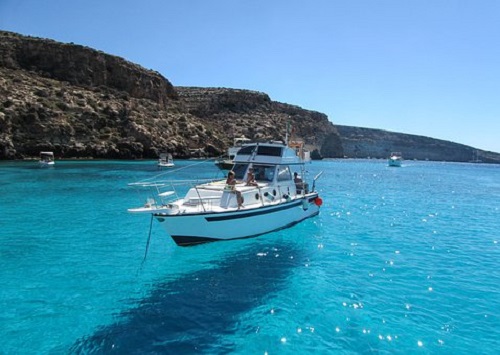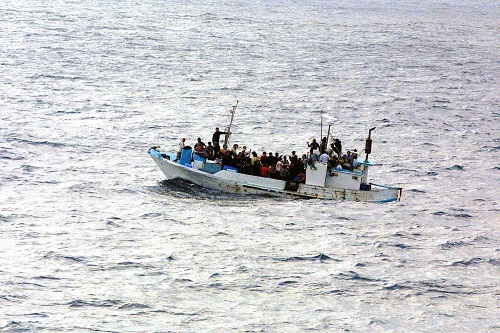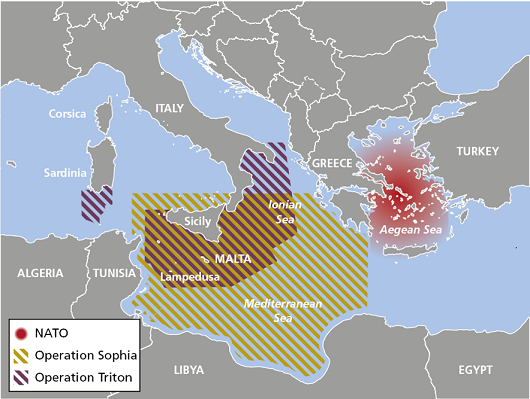OR HOW TO THWART MIGRANT SMUGGLERS
IN 7 STRUCTURED STEPS
What is claimed to have never happened before, has simply not happened yet.
This Case Study addresses the strategic threat posed by migrant smugglers in Southern Mediterranean. It demostrates the use of a structured analytic technique called High Impact-Low Probability Analysis (HI-LPA).
The purpose of this technique is to provide decision makers with an early warning that a seemingly unlikely event with potentially major resource repercussions (harm) is actually occurring or about to occur.
The seven steps in the method of HI-LPA are (as suggested in “Structured Analytic Techniques for Intelligence Analysts”, Heuer Jr., Richards J., Pherson, Randolph H.):
1. Clearly describe the unlikely event.
2. Define the high-impact consequences if it occurs, both immediate and secondary.
6. Develop corresponding indicators that would help detecting the start of the unfolding process.
7. Identify factors that could deflect a bad outcome or encourage a positive outcome.
1. Clearly describe the unlikely event.
A loose flotilla made up of around 200 ships filled with migrants sails from a number of beach points on the coasts of Libya and Tunisia towards Lampedusa. It has a total load capacity of some 160,000 people.
Let me make it clear from the start. I am not talking here about a Black Swan event. The latter is something imponderable, a new quality of an event. Thus it can’t be imagined or predicted. The only defence against it is raising your level of antifragility.
My scenario for HI-LPA, on the contrary, is by intent quite ponderable. Neither can I say that it has no known precedent, as would be the case with a Black Swan.
One rather massive precedent would be the migration wave of 2015 and 2016 that swept through the Balkans and crashed onto Hungary, Austria and Germany with an epic bang that is still resonating. An estimated 1.5 million people have walked the walk.
A more recent example, albeit of considerably weaker magnitude and resonance, is the arrival of several thousands of Central American migrants to the Mexican-US border in November 2018.
Nearer to the point, the issue of migrants attempting the crossing by sea from Northern Africa into Italy falls somewhere in-between, in terms of both time frame and magnitude. Since 2013, at least some 690,000 people of predominantly African origin have landed in Italy.
Past performance, however, is never a true indicator of the future one. It leads into the trap of false causality, a common predictors’ bias.
Consider an example postulated by Nassim Taleb in “Fooled by Randomness”: It is entirely possible that one in a zillion monkeys can type an exact replica of The Iliad. But does it mean that it will be able to come up with The Odyssey next?

Past performance always represents at least to some or another extent a manifestation of a random outcome, NOT ONLY of skill or knowledge. Future is no different from the past – it is as well part intentional and part random.
My point here is, there is no way of accurately predicting where the flood of migrants, with a little helping hand from organised crime, aka smugglers, will crest next.
If you are aware of the threat, there is a whole lot you can do to weaken the probability of it unfolding. Or if you can’t keep it from striking, to reduce the damage.
So, HI-LPA is not about the likelihood or a location. It’s about the damage.
2. Define the high-impact consequences if it occurs, both immediate and secondary.
Immediate:
- Simultaneous landing of 160,000 migrants on Lampedusa.
- Takeover of the island by migrants.
- Breakdown of law and order.
- Breakdown of access to Lampedusa by air.
- 6000 Italian nationals (island residents) become hostages to the situation.
Secondary:
- Takeover of the port and beaches will permit further flotillas to unload migrants on the island. Within 72 hours, up to some 0.7 million migrants can arrive (200 ships*4 voyages, distance 270 kms).
- Collapse of supply chain on Lampedusa, shortage of food and water, humanitarian disaster.
- Gradual spreading of panic in southern Italy.
- Run on banks, cash shortage, possibly leading to a collapse of the Italian banking system.
- Political crisis in the EU.
Now, before going any further, I believe it is useful to ask ourselves two questions:
– Is this scenario at all viable? Do smugglers realistically have the technical capability (knowledge+resources) to conduct such an operation? and
– is there a good business case for their doing it? In other words, is there a solid case for presence of intent (desire+expectation)?
The above conundrum can be typically resolved by the application of the expanded T4 matrix. But this key analytic technique is so versatile and effective that it deserves a separate case study. I’ll be working on bringing it to you next.
Due to this self-imposed constraint, I’ll use abductive reasoning instead. It aims to reveal plausible outcomes. The term comes from to ABDUCE (take away) and not to ABDUCT (escape with something or somebody). It is often considered to be a rather special type of inductive reasoning.
Using abductive reasoning is a way of generating hypotheses – explanations of (inferences about) phenomena meeting certain conditions. Excellent examples of abduction are offered by Sherlock Holmes.
 Contrary to popular opinion, Sherlock Holmes rarely, if ever, deduces anything. Instead, he is an expert abducer.
Contrary to popular opinion, Sherlock Holmes rarely, if ever, deduces anything. Instead, he is an expert abducer.
Consider this passage:
Holmes walks into the old second hand store and looks across the counter. The man standing there glances up before returning to his bookkeeping. Holmes turns to his companion and says, “That, my dear Watson, is the man we are looking for.“
“But Holmes, how on Earth can you know such a thing? You’ve not even spoken to him!”
“Ah, but you see Watson, it is simple.
I noticed that his beard is ragged and untrimmed, but its style implies that it is usually well kept. This means that he had little or no time this morning to undertake his usual particulars.
He is wheezing slightly, showing that he was out of the shop this morning in the dense smog we have been having all over London.
And, of course, he is wearing the stolen watch on a chain in his waistcoat.
“Eee Gads Holmes, I just don’t know how you do it!”, exclaims Watson.”
Holmes also left us a succinct and clear summary of the method:
“How often have I said to you that when you have eliminated the impossible, whatever remains, however improbable, must be the truth?” (The Sign of the Four, 1890)
Holmes was clearly a scholar of the Scottish philosopher David Hume who a century and a half earlier made the disconfirmation method a cornerstone of hypothesis testing.
Right, now back to Lampedusa.
Let’s start with an assessment of smugglers’ technical capability to plan and conduct an invasion of Lampedusa.
I guess there is pretty little doubt that from the angle of finances they won’t have any big difficulty in pulling it off. Between 2013-2018 smuggling organizations in Northern Africa checked in some 690,000 migrants for a passage to Italy. That feat should have netted them a bit (actually, quite a bit) in excess of one billion Euro. Could be more.
 A fraction of that booty would easily suffice to hire (or even buy) the 200 or so ships I estimated can be used for the Lampedusa project.
A fraction of that booty would easily suffice to hire (or even buy) the 200 or so ships I estimated can be used for the Lampedusa project.
Organizational and logistical skills are obviously not in short supply either. It has been proven time and again during the recent years. For example, on one occasion in October 2016, more than 10,000 migrants were rescued from 30 vessels at sea off the Libyan coast during just two days.
Neither are smugglers lacking in access to tactical military skills. IS combatants are periodically exposed among the “boat people”. Their numbers appear to be moderate, at least as much as can be gleaned from open sources, but there is no need to send a whole army either – or even a full battalion – to seize a largely civilian target.
The bottom-line: migrant smugglers have both resources and knowledge sufficient to conduct a run on Lampedusa.
Now, let’s look at the presence of intent.
In other words, is it worth the smugglers’ sweat?
Smuggling business in the Southern Mediterranean has until recently been booming. The only thing that smugglers needed to do was put migrants into inflatable craft, bring them into neutral waters off Libya and abandon.

Pulling off such a feat required a minimal outlay and zero sophistication. The rest of the journey to the EU was facilitated by NGOs. As a result, smugglers could offer their clients a very attractive survival rate and fairly low risk of failure overall.
That made smugglers’ business much safer and efficient. And by extension, more attractive to users of their services. And as a consequence, more profitable.
Early in 2018, or may be even earlier, the Italian police smelled rotten fish. NGO ships withdrew, some were impounded. And the steady flow of migrants to Italy ebbed to a trickle as if somebody had flipped a magical switch.
The attitude of the new Italian Government created a requirement for a change in the business tactics of migrant smugglers. The clients are still there in overwhelming numbers. Some estimates suggest that up to half a million, and other, up to three times as many, people are living in tent camps on the Tunisian and Libyan coast. Under the circumstances, aiming to score one last big hit looks like the most (if not the only) reasonable response to the now hostile business environment.
By sending even half a million people over to Lampedusa in just about three days, smugglers can take off to greener pastures at least half a billion Euro richer.
Does it sound tempting enough, or what?
3. Identify any recent information or reporting suggesting that the unlikelihood of the event is not static.
Over the past several months, both HUMINT sources and IMINT assets were reporting incremental build-up of migrant presence in the coastal regions of Libya and Tunisia, primarily on the border between the two countries.
There have also been bits and pieces of rumours (mostly from sources at B3-C3 level and below) pointing to the incremental concentration of sea-going vessels with a displacement suggestive of the capacity to carry some 500-800 people at unspecified locations along the southern Tunisian and Libyan coast.
Does the above looks too thin to build a solid case for the launching of a pre-emptive deployment of assets? Well, let’s be honest with ourselves – it does.
But let’s stay rational – it’s not very realistic to expect that you’ll be able to pick up from open sources a lot of information related to migrant and smuggler movement. Unless you drop into the area and chat up people on location.
If you are not fluent in Arabic, UNHCR offices may be a good place to start. Their folks might not know what they actually know.
4. Define triggers that may propel developments towards the unlikely outcome, as well as factors that could greatly accelerate the timetables.
- The Italian Government takes the political decision to return all migrants picked up from boats or out of the water back to Libya.
Such a decision would blow smugglers straight out of the water and with an almost immediate effect. An invasion of Lampedusa becomes pressing business. And also something very personal. A just (and sweet) revenge.
- EU takes a political decision to handle all asylum and migration requests through a system of processing centres outside EU territory.
This decision will have an equally devastating impact on smugglers’ model of business as usual, albeit in a medium- to long-term perspective. Still, it might well merit a quick rethinking of business processes on their part.
- A sudden and sharp rise in migrant/refugee traffic in the direction of Greece is sure to capture the undivided attention of the EU.
In reality, it may be just a diversion to draw resources and assets away from Lampedusa. Same as is happening with the apparent current focus of migrant smugglers in the Mediterranean on the Morocco-Spain connection.
But climbing over the fence into Ceuta or Melilla is not all that attractive a proposition. It does not offer any guarantee of ending up on the EU mainland. Quite the opposite, as a matter of fact.
And a sea crossing to Spain has only the smallest of chances for becoming a major migrant smuggling channel. The reason is SIVE – Sistema Integrado de Vigilancia Exterior, or in English, Integral System of External Surveillance, deployed and operated by the Spanish Guardía Civil since some 15 years.
It now provides nearly gapless coverage of the whole extension of the Spanish coastline. The initial objective of its implementation was to thwart drug trafficking from Morocco to Spain by means of speedboats.
At the time, it was a highly effective and lucrative method for the smuggling of cocaine and hashish into Europe. The objective stated by the Guardía Civil was neatly accomplished. As by around mid-2000s the intercept rate climbed above some 95%, a whole fleet of rugged speedboats was beached and abandoned.
I once had an opportunity to visit a SIVE Operations Centre in the vicinity of Malaga and witness a demonstration of its capabilities. It was ten years ago, in 2009, and even then it was pure fireworks.
Much slower inflatable craft have even less chance against SIVE than the spectacular speedboats. And the repetition of the NGO ruse is rather unlikely. Its cover has been blown.
- Next comes a sudden and sharp rise in refugee flow caused by an upsurge in military hostilities in Chad, Sudan, Niger and Mali provoked by IS combatants displaced from Syria.
Nothing really new here, such surges have been known to happen from time to time. They lead to spikes in demand for smugglers’ services that result in increases in the price of passage and make expansion of capacity particularly desirable. Under the circumstances, a one-off hit on Lampedusa acquires a particular attraction.
5. Develop several plausible pathways that explain how the seemingly unlikely event could unfold. Focus on specifics of what could be pre-requisite or precursor developments that could move the unfolding event towards the next phase in its unfolding.
- Progressive souring of relations between the EU and Turkey leads to the ending of the money-for-refugees deal. Turkey displays a growing intransigence on the refugee issue amidst increasingly harsh anti-EU rhetoric.
It encourages refugees and migrants on its territory to leave. That leads to a build-up of refugee/migrant presence in areas of the land border with Greece and Bulgaria. A similar accumulation is also observed in the staging areas for sea crossing to the Greek islands.
- Within roughly the same time frame, one of the warring factions in Syria launches offensive operations.
NATO focuses its political and military attention on Eastern Mediterranean. The number of naval and air assets on patrol in Southern Mediterranean is reduced.

- About one week into the new crisis, with the attention of the EU political circles split between the two hotbeds of tension and EU/NATO naval assets redeployed to Eastern Mediterranean, the first flotilla departs from the Libyan/Tunisian coast to arrive at Lampedusa shortly after sunrise.
6. Develop corresponding indicators that would help detecting the start of the unfolding process.
Indicators are used to track events and warn of changes in the status quo. Development of indicators is an absolutely essential but highly delicate process. An art in itself.
Flawed indicators will lead to unfitting actions and lead astray attention and assets. A good indicator is typically observable (recordable), valid, reliable, stable and unique. (For those interested in the subject I can recommend “Analyst’s Guide to Indicators”, Pherson, Randolph H., Pyrik, John, Pherson Associates LLC, 2018).
It is common to pair indicators to specific scenarios. Our present one calls for developing primarily estimative indicators that measure change that increases the probability of the unfolding of an undesirable process.
In essence, they should alert us to the unfolding of one of the alternative (or concurrent) futures we proposed in the section five above.
Indicators applicable to our present scenario may include:
- A measurable increase in the presence of refugees/migrants observed in areas adjacent to the Turkish land border with Bulgaria and Greece.
- Bus convoys observed leaving refugee camps in the South/Southwest of Turkey.
- Increased smuggler activity observed on the Western coast of Turkey around Behram/Ayvalik, Cesme, Güzelcamli, Akyarlar.
- In Southern Mediterranean, vessel concentration areas are observed to be increasingly overlapping with those of migrant concentration ones.
- A pick-up in night-time activities is observed in migrant camps located in coastal areas on both sides of the Libyan-Tunisian border.
- An increase (possibly incremental) is observed in the deliveries of diesel fuel and motor oil drums to areas of vessel concentration. It can be corroborated by an increase in the observed numbers of empty discarded fuel barrels.
7. Identify factors or actions that could deflect a bad outcome or encourage a positive outcome.
- Tasking Eurosur Fusion Services and SatCen assets to produce geospatial intelligence focussed on activity hotspots on the Libyan and Tunisian coasts.
Eurosur stands for the European Border Surveillance System.
It was piloted by Spain through the deployment of the national SIVE system mentioned above and has gradually grown into an EU-wide structure.
Eurosur Fusion Services include automated vessel tracking and detection capabilities, allowing the detecting of anomalies and predicting vessel positions. Fusion Services can use optical and radar satellite technology to locate and monitor positions of vessels suspected to be engaged in people smuggling.
Eurosur goes beyond situational awareness. It indicates the adequate level of operational reaction at different border sectors. EU Member States have divided their external land and sea borders into sections. Each of these is assigned an impact level — low, medium or high. It refers to a particular sector’s security against identified risk levels for illegal border crossing or cross-border crime.
Measures to reduce the risks essentially remain the responsibility of individual Member States. But in the case of “high impact level” border areas MS may request operational assistance from Frontex in the form of prioritized spatial services, a joint operation or rapid intervention.
SatCen stands for the EU Satellite Centre.
Monitoring of refugee displacement through daily high-resolution satellite passes is one of its core stated objectives. One of its assets relevant to this scenario is the Synthetic Aperture Radar (SAR).
It is used to create images of objects, landscapes or seascapes. SAR uses the motion of the radar antenna over a targeted region to provide finer spatial resolution than is possible with conventional beam-scanning radars. SAR is typically mounted on a moving platform such as an aircraft or spacecraft. Current airborne systems provide resolutions of about 10 cm.
 SAR imagery products are fed into the analytic process to produce valuable and possibly actionable intelligence through REACT – Radar imagEry Applications supporting ACTionable intelligence – mechanism.
SAR imagery products are fed into the analytic process to produce valuable and possibly actionable intelligence through REACT – Radar imagEry Applications supporting ACTionable intelligence – mechanism.
- Initiate low-altitude drone/UAV overflights of hotspot areas for intelligence collection and dissuasion purposes.
While SAR and other space assets are a high-end asset, they are also high-cost ones. Monitoring of indicators for relatively compact areas, like in our case, can be quite effectively supported also by lower-end and -cost assets of the drone kind.
Their further advantage is the live streaming of image intelligence, which is particularly valuable for the monitoring of fluid and time-sensitive scenarios.
- Position naval assets for deterrence.
Since I am not a military expert, I am reluctant to go into more detail. My only observation would be that it generally seems to be a better idea to prevent empty smugglers’ ships from loading rather than to try and stop them on their way to Lampedusa.
- Take the political decision to stop accepting asylum applications on EU territory AND deploy advance EU refugee processing centres in primary hotspot areas on the Libyan/Tunisian coast SIMULTANEOUSLY with its announcement.
A gap between words and deeds can only provoke smugglers to action.
- Make the Lampedusa airport a harder target for a landing.
This is another measure that I happily leave to the military folks. My rationale for mentioning it at all is simple. The success of the smugglers’ scenario hinges on landing as many people as possible before the arrival of reinforcements sent from mainland Italy (including Siciliy).
Naval assets will take days in arriving, which is just fine with the smugglers. What they will attempt to do in the first half hour of the invasion is to control the island landing strip to prevent the arrival of reinforcements by air.
If this task is accomplished, the island is as good as in their hands.
- Harden access to Lampedusa´s shore in areas suited for the landing of migrants.
This is one more tactical military issue and I am quite happy to leave its discussion to military experts who (I hope) might be reading this case study.
May be the solution is open-sea mesh nets. May be it is floating booms held together by above-water cables. May be it is something entirely different. I’ve got no clue.
It is quite clear, however, that regardless of what solution is chosen it will be a bit of a last-resort measure. Its activation could only be expected to create a stalemate situation. But from strategic view it is still better than letting the island fall without at least an attempt at resistance.
- And last but not least, draw up post-invasion evacuation plans for Lampedusa residents…

